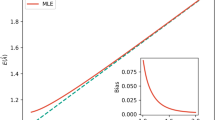Abstract
Zipf’s law – or Estoup-Zipf’s law – is an empirical fact of computational linguistics which relates rank and frequency of words in natural languages. The law suggests modelling by distributions of “hyperbolic type”,. We present a satisfactory general definition and an information theoretical characterization of the resulting hyperbolic distributions. When applied to linguistics this leads to a property of stability and flexibility, explaining that a language can develop towards higher and higher expressive powers without changing its basic structure.
Preview
Unable to display preview. Download preview PDF.
Similar content being viewed by others
References
Estoup, J.B.: Gammes Sténographique, Paris (1916)
Harremöes, P., Topsøe, F.: Maximum entropy fundamentals. Entropy 3, 191–226 (2001)
Mandelbrot, B.B.: On the theory of word frequencies and on related Markovian models of discourse. In: Jacobsen, R. (ed.) Structures of Language and its Mathematical Aspects, New York, American Mathematical Society (1961)
Schroeder, M.: Fractals, Chaos, Power Laws. W.H. Freeman, New York (1991)
Shannon, C.E.: Prediction and entropy of printed english. Bell Syst. Tech. J. 30, 50–64 (1951)
Zipf, G.K.: Human Behavior and the Principle of Least Effort. Addison-Wesley, Cambridge (1949)
Editor information
Editors and Affiliations
Rights and permissions
Copyright information
© 2006 Springer-Verlag Berlin Heidelberg
About this chapter
Cite this chapter
Harremoës, P., Topsoe, F. (2006). Zipf’s Law, Hyperbolic Distributions and Entropy Loss. In: Ahlswede, R., et al. General Theory of Information Transfer and Combinatorics. Lecture Notes in Computer Science, vol 4123. Springer, Berlin, Heidelberg. https://doi.org/10.1007/11889342_50
Download citation
DOI: https://doi.org/10.1007/11889342_50
Publisher Name: Springer, Berlin, Heidelberg
Print ISBN: 978-3-540-46244-6
Online ISBN: 978-3-540-46245-3
eBook Packages: Computer ScienceComputer Science (R0)



